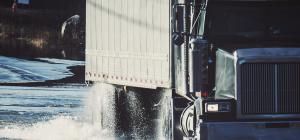
Climate change in the Arctic and radon gas: a rising threat from the ground up

Temperature trends in the sub-Arctic and Arctic have been notably rising in recent decades. Data collected over last half century shows that the annual mean temperature in Alaska has increased 3 to 4 degrees. This warming trend is impacting water systems, fuel supplies, the length of the growing season and exposure to allergens. Warmer temperatures in the arctic are also accelerating the melting of the permafrost layer. This process often involves a complex cycle of thawing and refreezing and can lead to sudden and severe destabilization of infrastructure such as roads, pipelines, buildings and homes. Some communities in Russia and Alaska have already had to be relocated as the permafrost beneath them has become too unsafe to inhabit.
Permafrost thawing in the Arctic: a negative feedback loop
Almost one quarter of the land in the northern hemisphere is covered in permafrost, which is defined as the layer of ground that remains completely frozen (at 0 °C or colder) for more than 2 years in a row. Permafrost is made up of frozen and decomposed biomass that is stored as methane and carbon dioxide. In Canada, some regions are covered by continuous permafrost- large sheets of frozen material while other regions are covered by isolated areas known as discontinuous permafrost. The depth of permafrost varies and can range from one to hundreds of meters deep.
As permafrost melts, it releases gases and contaminants stored in and below the surface. For soil gases such as radon, permafrost melting increases the amount of radon released from the soil. For greenhouse gases, permafrost melting leads to a diffusion of methane (and thus carbon) directly into the atmosphere. This process is particularly troubling as more methane in the atmosphere can lead to increased warming, causing even more melting and effectively creating a deleterious feedback cycle.
The impact of melting permafrost on radon levels in homes
Radon-222 is part of the natural breakdown of uranium and the only uranium daughter that exists in a gas form[1], which eases its circulation in soil pores. Frozen conditions do not hinder the breakdown of uranium but permafrost acts like a cap and prevents radon gas generated in the underlying bedrock from reaching the surface. As the permafrost layer melts, radon gas is released from soils and ice. As the phenomenon of rapidly melting permafrost is relatively recent, limited work has quantified how much radon gas is being released. Monitoring of radon and radon progeny in outdoor air and water is being done in Greenland, northern Norway, Canada, and the USA (Alaska) but monitoring of radon indoors has been identified as an important gap by arctic researchers. Elevated radon inside homes presents an increased risk of lung cancer for inhabitants.
Communities in regions that are home to uranium rich soils and permafrost layers are most vulnerable to thawing. In the absence of measurement data, UK researchers have developed models to better understand potential indoor radon risks for housing in these regions. The results of these models are striking- homes with basements could see radon levels increase up to 100 times their pre-thaw levels. These models indicate that radon gas concentrations could also stay elevated in homes for up to 7 years, depending on the thickness of the permafrost and the rate of melting. Alternately, homes elevated by stilts or piles, a common building strategy in some arctic regions, were unlikely to see radon levels increase.
Experts at the Russian Academies of Science suggest that radon exposure will play a greater role for arctic communities going forward. The arctic permafrost is melting much more quickly than had been expected, with some regions already experiencing abrupt thaws. These faster rates could mean that radon modeling outputs maybe be a conservative underestimates of potential new indoor radon exposure.
Accelerated melting may also open up new land on which to build much needed new housing. Without the permafrost layer to contend with, features such as basements may become more common in northern homes. Basements tend to increase the amount of radon ingress due to the greater ground contact surface area so radon awareness and testing programs will be useful for new artic housing.
Conclusion
As global attention focuses more on climate action, there is little time to spare for the already melting permafrost. Current estimates suggest that over 3 million northern residents will be impacted by permafrost degradation and loss by 2050. Efforts are being taken to try and mitigate community-level impacts. Innovative technologies that adapt building foundations to warming conditions are being studied for existing and future arctic structures. The automatic installation of a sub-slab depressurization system might be encouraged in future developments in Northern communities to prevent radon from entering dwellings. Researchers are also evaluating how permafrost hazard maps could be integrated into future community planning in Canada’s arctic. Governments are already encouraging residents to test for radon in Alaska and Yukon, and there are Canadian programs that support affordable community testing in all regions of Canada. Recognizing the potential risk from indoor radon exposure is another import piece to help northern residents navigate the changes ahead.
[1] Radon-220 also known as Thoron, is another radioactive gas which may be released from thorium rich soils. Thorium is not as common in Canada as uranium although some regions of the north have higher concentrations.
Author
Art Nash is an Energy Specialist at the University of Alaska Fairbanks
Anne-Marie Nicol is an EH & KT Scientist at the NCCEH








